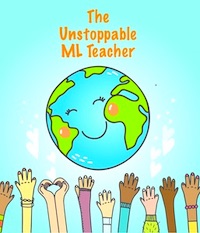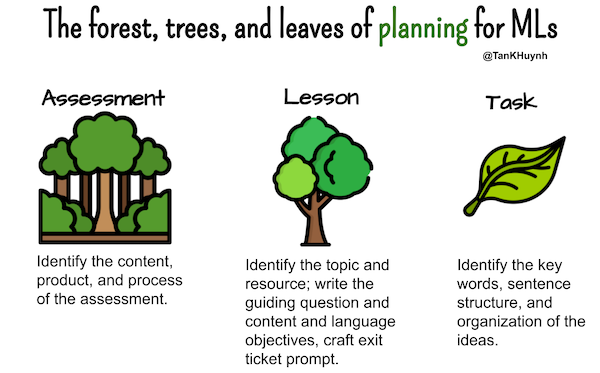Planning Our Lessons: Forest, Trees, Leaves
A MiddleWeb Blog
 I just want to know how he plans his lessons… is what one participant anonymously wrote on one of my end-of-webinar surveys.
I just want to know how he plans his lessons… is what one participant anonymously wrote on one of my end-of-webinar surveys.
As helpful as delving into deep pedagogy can be, sometimes we just want to know what will help us in our everyday teaching lives.
If you are familiar with my work, then you know I love metaphors. One of my favorite metaphors for thinking about our work with multilingual learners (MLs) is the forest, trees, and leaves image.
I have taken this metaphor, revised it, and made it the guiding metaphor for my upcoming Corwin book with Beth Skelton called Long-term Success for Experienced Multilinguals where we share an instructional framework for teaching students who are often labeled as “long-term English learners.” You can get a preview in our free June 5 webinar.
This metaphor works naturally with Wiggins and McTighe’s Understanding by Design approach. The starting point of this instructional planning technique is the assessment (the forest) and all things follow from the assessment we create.

I draw my approach to classroom planning from several key resources:
• Assessment-level planning: How to Differentiate Instruction in Academically Diverse Classrooms (Tomlinson, 2017)
• Lesson-level planning: Inquiry Design Model (Swan et al., 2018) and Talk, Read, Talk, Write (Motley, 2016)
• Task-level planning: Building Academic Language (Zwiers, 2014)
This article is the super-condensed version of a full-day workshop. For teachers new to the field, you might feel overwhelmed by the speed with which I describe things. This compact post is meant more for teachers who have some experience planning lessons on a daily basis. Scholars have written volumes on each of these topics; my goal here is to show how we can stitch all of these pedagogical concepts together.
Forest (assessment planning)
I see the assessment as the forest – the most global view of the unit. I repurposed Carol Ann Tomlinson’s framework for differentiation (2017) as my framework for planning the assessment and asked myself these questions in this order:
1. What are the content and concepts students have to learn?
2. What is the product students have to produce (skills)?
3. What is the process for engaging with the assessment?
Here’s an example of the long-term assessment I designed for my 8th grade “From Exploration to Colonization” history unit.
1. Content: Students will research one individual from a list of explorers and colonizers.
2. Product: Students will create a historical fact-based diary written in the voice of the explorer/colonizer.
3. Process: Students will use a graphic organizer to scaffold their diaries.
Tree (lesson planning)
Now that I have my assessment, every lesson is rooted in it. In other words, the purpose of every lesson is to support students to be successful in the evaluation. There are many branches of a lesson, and the ones I use to plan my lessons come from Inquiry Design Model (Swan et al., 2018):
1. Topic: What is the topic students are learning about?
2. Guided question: What question should students be able to answer by the end of the lesson?
3. Resource: Will students learn from a hands-on activity, a text, or a video?
4. Combined objective: Write an objective that identifies the content and the language demand of the lesson. This can also include a cultural objective.
5. Formative data: What will students do to demonstrate learning?
I use this framework because it makes instruction clear, focused, and intentional. Everything we do drives us toward the guiding question, which is rooted in the content. For example, a particular lesson from the Explorers to Colonizers unit would look like this:
1. Topic: La encomienda system
2. Guided question: How did the encomienda system work?
3. Resource: An article about the encomienda shared on Google Doc
4. Combined objective: Describe how the encomienda system worked by annotating an article on Google Doc with a partner.
5. Formative data: Students annotations on the Google Doc + Harkness Discussion

Work on a Mission, Florián Paucke (1719-1789), Public domain, via Wikimedia Commons
For this lesson to be successful, students have to be able to describe the encomienda system of colonization. In students’ annotations I will look for details that describe such things as who were the people involved, what they made other people do, how the colonized people were treated, and when did it start.
This is why the combined content and language objective is so important. It determines what students are going to do. The formative data is where we look to see how successful students were.
With these big blocks shaping the structure of my lesson, it’s now time to think about making the content comprehensible (Krashen, 1981). One way to do this is to apply the Talk, Read, Talk, Write (TRTW) framework to scaffold the instruction (Motley, 2016).
I use the TRTW structure as the sequencing for my lesson as it makes learning more engaging for students. However, I have modified it by combining the Talk 1 and Read as one step and the Talk 2 and Write as the second step.
1. Talk 1-Read: Students work in small groups to read the text. At the end of each paragraph, students pause and collaborate to synthesize the paragraph.
2. Talk 2-Write: Students write a concise annotation using the Noun Verb Detail structure to teach students to paraphrase without plagiarism.
Here’s a video of a group of 8th graders engaged in this very lesson. You will notice how engaged they are and the critical thinking required to write a concise NVD annotation.
I love this approach because students are actively engaged in learning the content. At the same time, they are developing literacy and language skills. Most of my students enjoy TRTW because it’s a fun way to learn content instead of passively listening to me lecture.
At the end of the day, the students are doing most of the work rather than me. Most of my work was planning and explaining the instructions. As students are working, I meet with groups that need extra support.
Leaf (task planning)
Content-based writing can be highly exacting in terms of how to speak and write about the content. For this reason it requires higher levels of scaffolding. To do that, I call on Zwiers’ framework for features of academic language (2014):
• Word level: What are the content-specific and Tier 2 words students need to write about?
• Sentence level: How is a sentence structured?
• Discourse level: What is the sequencing of the ideas?
This framework helps me consider the words the students have to use, how to use them in a sentence, and the sequencing of the ideas. I attend to the language features of the language by using Zwiers’ model. Here’s how it looks when I scaffold the instructions for the historical non-fiction diaries:
- The word-level scaffold reminds students to identify significant names, locations, and events as I am looking for specific historical details.
- To scaffold the sentence level, I tell students they must use the past tense when describing an event, present tense when describing the person’s feelings and thoughts, and the future tense to link to the next diary.
- I scaffold the sequencing of the ideas in a diary entry by telling students the ideas that need to go in the beginning, middle, and end.
Conclusion: It’s all about Intentionality
Yes, this article was intense! First and foremost you need to remember is that teaching language learners requires steadfast intentionality.
My greatest intention is to be clear. Like Brené Brown said, “Clear is kind.” Clarity is essential for language learners, and research suggests that clarity is one of the most impactful drivers of student achievement (Hattie, 2012) for all of our learners.
When our instructions are comprehensible, students know what to do. When students know what to do, they are more likely to achieve at the highest levels.
As we plan and teach lessons, everything we do has a purpose, and the purpose is always anchored to the assessment. Assessments are determined by the learning objectives, which are anchored in the standards.
I recommend that the next time you plan a new unit, pull this article out and let it guide you through each aspect of your planning. If you are a coach or new-teacher mentor, share it with your colleague and think through the steps with them.
I sure wish I’d had a mentor teacher who walked me through my first units the year I started teaching. I hope this article provides some of that guidance so that you (or your mentees) can become part of the forest instead of being lost in it.
Which aspect of this framework is already a strength in your practice?
References
Krashen, S. (1981). Second Language Acquisition and Second Language Learning. Oxford Press.
Hattie, J. (2012). Visible learning for teachers: Maximizing impact on learning. Routledge.
Motley, N. (2016). Talk, read, talk, write (2nd edition). Canter Press.
Swan, K., Lee, J., & Grant, S. G. (2018). Inquiry design model: Building inquiries in Social Studies. National Council for the Social Studies and C3 Teachers.
Tomlinson, C. A. (2017). How to differentiate instruction in academically diverse classrooms (3rd edition). Association for Supervision and Curriculum Development.
Wiggins, G. P., & McTighe, J. (2005). Understanding by Design (2nd ed.). Association for Supervision and Curriculum Development.
Zwiers, J. (2014). Building academic language: Meeting Common Core Standards across disciplines, Grades 5-12 (2nd edition). Jossey-Bass.


































